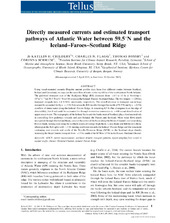| dc.contributor.author | Childers, Katelin | |
| dc.contributor.author | Flagg, Charles | |
| dc.contributor.author | Rossby, Thomas | |
| dc.contributor.author | Schrum, Corinna | |
| dc.date.accessioned | 2016-06-03T12:36:07Z | |
| dc.date.available | 2016-06-03T12:36:07Z | |
| dc.date.issued | 2015-11-24 | |
| dc.Published | Tellus. Series A, Dynamic meteorology and oceanography 2015, 67(28067) | eng |
| dc.identifier.issn | 1600-0870 | en_US |
| dc.identifier.uri | https://hdl.handle.net/1956/12059 | |
| dc.description.abstract | Using vessel-mounted acoustic Doppler current profiler data from four different routes between Scotland, Iceland and Greenland, we map out the mean flow of water in the top 400 m of the northeastern North Atlantic. The poleward transport east of the Reykjanes Ridge (RR) decreases from ~8.5 to 10 Sv (1 Sverdrup=106 m3 s−1) at 59.5°N to 61°N to 6 Sv crossing the Iceland–Faroes–Scotland Ridge. The two longest ~1200 km transport integrals have 1.4–0.94 Sv uncertainty, respectively. The overall decrease in transport can in large measure be accounted for by a ~1.5 Sv flow across the RR into the Irminger Sea north of 59.5°N and by a ~0.5 Sv overflow of dense water along the Iceland–Faroes Ridge. A remaining 0.5 Sv flux divergence is at the edge of detectability, but if real could be accounted for through wintertime convection to >400 m and densification of upper ocean water. The topography of the Iceland Basin and the banks west of Scotland play a fundamental role in controlling flow pathways towards and past Iceland, the Faroes and Scotland. Most water flows north unimpeded through the Iceland Basin, some in the centre of the basin along the Maury Channel, and some along Hatton Bank, turning east along the northern slopes of George Bligh Bank, Lousy Bank and Bill Bailey’s Bank, whereupon the flow splits with ~3 Sv turning northwest towards the Iceland–Faroes Ridge and the remainder continuing east towards and north of the Wyville-Thomson Ridge (WTR) to the Scotland slope thereby increasing the Slope Current transport from ~1.5 Sv south of the WTR to 3.5 Sv in the Faroes–Shetland Channel. | en_US |
| dc.language.iso | eng | eng |
| dc.publisher | Co-Action Publishing | en_US |
| dc.rights | Attribution CC BY 4.0 | eng |
| dc.rights.uri | http://creativecommons.org/licenses/by/4.0 | eng |
| dc.subject | ADCP | eng |
| dc.subject | current measurements | eng |
| dc.subject | northeast Atlantic transport patterns | eng |
| dc.subject | repeat sampling from vessels in regular traffic | eng |
| dc.subject | Faroes–Shetland Channel | eng |
| dc.subject | Iceland–Faroes Ridge | eng |
| dc.title | Directly measured currents and estimated transport pathways of Atlantic Water between 59.58N and the Iceland-Faroes-Scotland Ridge | en_US |
| dc.type | Peer reviewed | |
| dc.type | Journal article | |
| dc.date.updated | 2016-04-07T08:54:02Z | |
| dc.description.version | publishedVersion | en_US |
| dc.rights.holder | Copyright 2015 K. H. Childers et al. | en_US |
| dc.identifier.doi | https://doi.org/10.3402/tellusa.v67.28067 | |
| dc.identifier.cristin | 1310851 | |
| dc.subject.nsi | VDP::Matematikk og Naturvitenskap: 400 | en_US |

